
views
Purchasing a Venus Flytrap
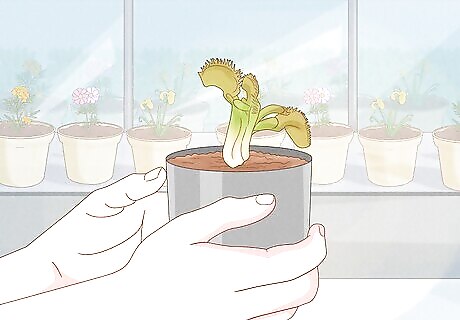
Consider if you can properly care for a Venus flytrap. These plants require a regular care regimen. You will be able to keep your Venus flytraps inside or outside, planted in pots. Venus flytraps will need a good deal of sunlight and warmth for most of their growing cycle. You will need to have patience, as Venus flytraps require a period of dormancy during the winter. They will grow less and require grooming. Be prepared to trim dead leaves and blooms off of the plant to keep it healthy and to water the plant on a schedule. You may need to feed the trap with crickets or other insects if it doesn't catch many on its own.
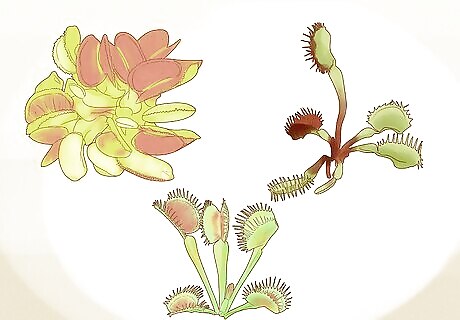
Learn about different varieties of Venus flytraps. These plants have several different breeds or species. Some breeds are hardier than others. If you are just getting started with Venus flytraps, growers recommend the following types of Venus flytraps: King Henry, Dentate Traps, Dingley Giant, or Microdent varieties. These types tend to be hardier plants that are less susceptible to common problems like disease and root rot. The DC XL variety of Venus flytrap is known to be very hardy, but these can be more expensive than other types.

Look at local retailers for a Venus flytrap plant. Many nurseries and home and garden stores will have them in stock during their growing season. Venus flytraps are usually sold in season, which typically runs from mid-spring to mid-autumn. You can search at larger retailers like Home Depot or Lowes in the garden section. Walmart can even carry them, if your local store has a garden section. Smaller, privately owned nurseries are also likely to have these in stock when they are in season.
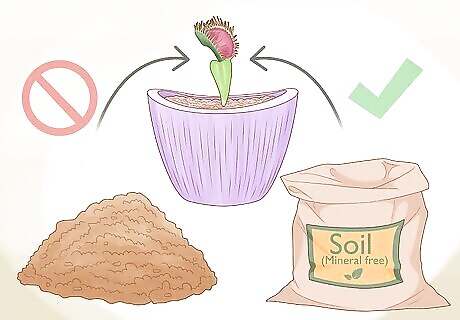
Choose a plant. You will want a plant that looks healthy and that is growing well. Avoid any Venus flytrap plants that are potted in regular soil. These plants require a special kind of soil that is free of minerals. Look for a plant that has vibrant green leaves and shoots. The traps themselves will be green or even reddish in color. If a plant has many dead leaves that have not been trimmed, don't choose this plant. Grooming is a part of Venus flytrap maintenance, and you will want to purchase a plant that has been properly cared for. Keep an eye out for any plants that appear wilted, dull in color, or that look sparse. These plants might have a fungal or bacterial problem and should be avoided.
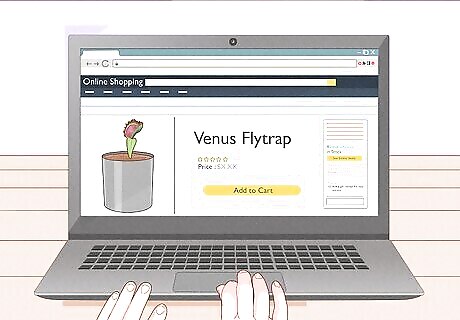
Buy a Venus flytrap online, alternatively. If you are having trouble finding one in a retail store, there are many online sources for purchasing Venus flytraps. Online sources, such as www.flytrapstore.com and www.growcarnivorousplants.com sell many varieties of Venus flytraps. You are more likely to find more variety in breed or species of Venus flytrap through online sellers. This can be especially helpful if you are new to raising Venus flytraps and are looking for a specific variety that is hardier, or if you are looking to expand your collection to include more variety in breeds.
Caring For Venus Flytraps
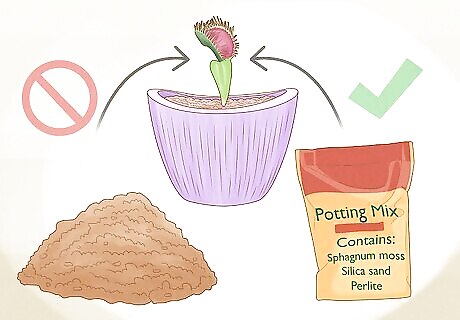
Keep your Venus flytrap in the right kind of soil. Regular garden or potting soil is not appropriate for growing these plants. Most of the time, if you buy a Venus fly trap it will already be potted in suitable soil. However, if you need to add more soil to your potted plant, you will need to get the right kind. Venus flytraps will die if they are planted in regular garden soil or potting mix. These plants naturally live in soil mediums which are free draining and contain almost no nutrients or soluble minerals. Venus flytraps naturally grow in sandy soil that has very low fertility and very little organic material. This soil is usually slightly acidic. You can buy potting mix specifically geared towards Venus flytraps. This usually contains a mixture of sphagnum moss, silica sand, and perlite.
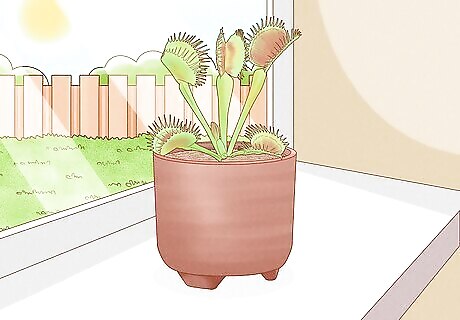
Keep your Venus flytraps in an area which gets regular sun. They will not thrive in areas with too much shade. During the spring and summer growing season, Venus flytraps will do best if they are kept in pots outdoors in direct sunlight except in the hottest weeks of summer. In the hottest part of summer, you should move your Venus flytraps to an area with partial shade or the plants will get too much direct sunlight. You can also grow Venus flytraps indoors, but they will not be as vibrant. Artificial light sources that are recommended are LEDs and fluorescent bulbs.
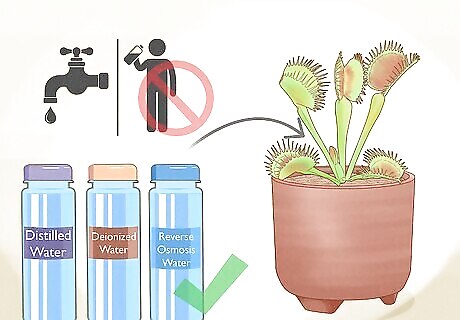
Water your Venus flytrap with pure water. You should never water this plant with regular tap water. Tap water and bottled drinking water contains too many minerals. This will kill a Venus flytrap. You should only water your Venus flytraps with distilled water, deionized water, or reverse osmosis water. You can buy these bottled in the grocery store or garden stores and they are relatively inexpensive. You can also collect rainwater to use to water your Venus flytrap.
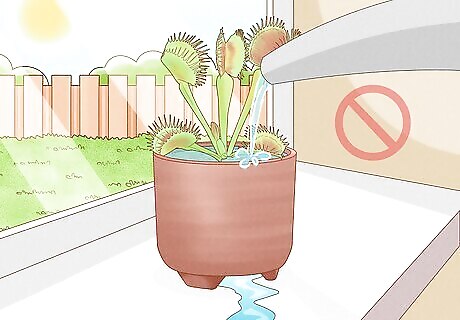
Avoid overwatering your plant. Venus flytraps can become too moist and this will promote bacterial or fungal growth that can kill the plant. How often you water your flytrap will depend on a number of factors. If you are keeping your plants in an area with lots of sunlight and humidity, they will dry out faster. If they are in a cool area, the soil will remain moist for longer periods. Most Venus flytrap growers recommend watering your plant every 2-5 days if you are keeping it in an area with more heat and sunlight. If you keep your flytrap in a cooler area with more shade, watering your plant every 8-10 days, or even up to every 14 days, is recommended. A good test to see if your plant needs to be watered is to feel the soil. If it is dry or cracked, the plant needs to be watered. Using a turkey baster to water your plant gently is recommended by Venus flytrap growers.
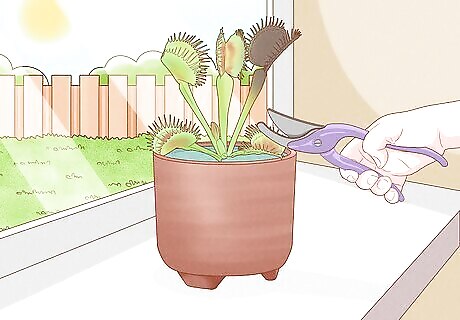
Groom your plant regularly. You will have to trim off dead leaves and blooms from the plant to keep it healthy. Dead leaves not only make a plant look unhealthy, but can actually shade new growth leaves and prevent them from getting adequate sunlight. If leaves are brown and dry, they are dead. In many cases these can be gently pulled off of the stem and disposed of. Otherwise, you will need to trim off dead leaves and blooms gently with plant shears.
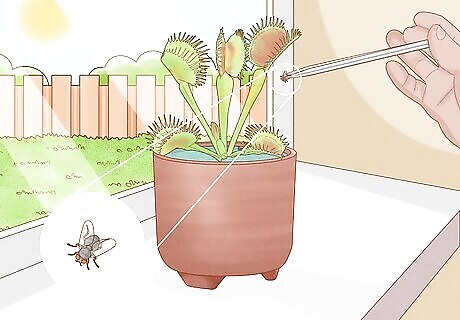
Feed your Venus flytrap. Most plants require fertilizer, but in the case of carnivorous plants like Venus flytraps, you will need to feed it insects. Trap flies and put them into the traps while still alive. The motion will trigger the plants to close and trap the insect inside. It will slowly be digested by the plant's natural enzymes. This can take several weeks. If you are having trouble getting flies into the traps, put them in a jar and refrigerate them. The cold will make them sluggish and easier to put into the traps. If you can't find flies, you can feed the plant small earthworms. You can also feed it with live insects like crickets or mealworms that are used to feed lizards and reptile pets. You can buy these at pet supply stores. When feeding, you should only feed one or two traps at a time. Avoid having all of the traps on a plant full at once. Digesting all those insects will expend the energy of the plant and can cause it to wither.
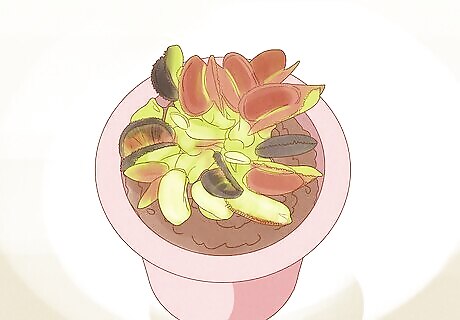
Watch your plant for dormancy. Venus flytraps go through a yearly period of dormancy in the winter. This period lasts from three to five months, but cannot be any shorter than 10 weeks for the plant to continue to thrive. The plant still needs plenty of light during this time, but it can survive in cooler temperatures. Colder weather in the fall triggers dormancy in a Venus flytrap. During this period, growth slows and traps become sluggish. During its dormant period, you can still keep the Venus flytrap outdoors but bring it inside if temperatures fall below or close to freezing. Care for a venus flytrap during dormancy is a little different. You should still water and feed the plant during dormancy, but the plant will require less water and food during this period. Check the soil of the plant to make sure it is dry before watering and decrease the frequency of insect feedings.




















Comments
0 comment